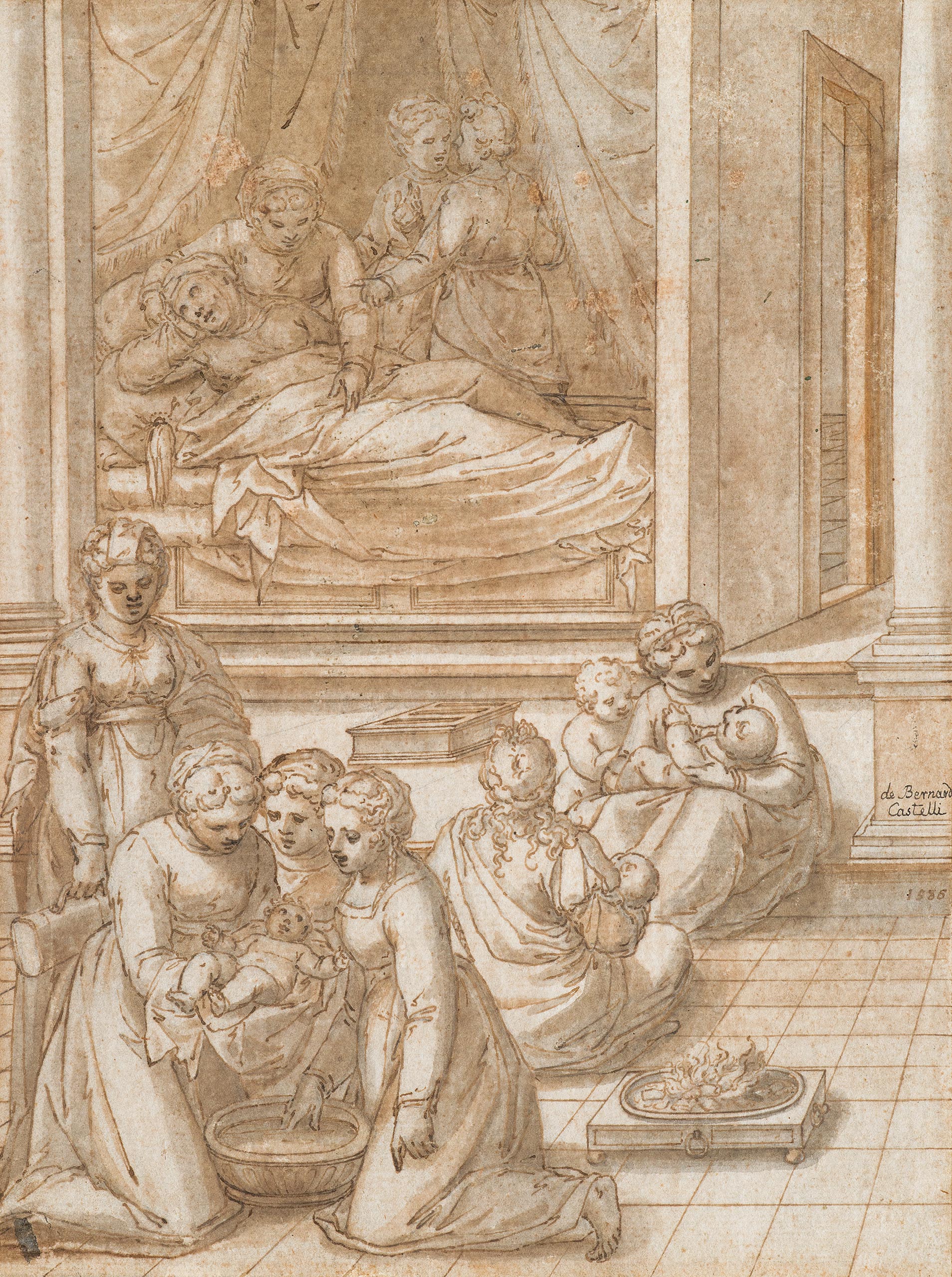
Castello
Giovanni Battista, il Genovese
Genoa 1549 — 1639
The Birth of the Virgin
Black chalk, pen and brown ink, brown wash.
Dated 1586 in pen and ink on the right-hand side, on the rim of the step by the artist. Subsequently inscribed de Bernard Castelli in pen on the base of the right-hand column. Laid down on paper.
228 x 172 mm (9 x 7 in.)
Agnese Marengo et Maurizio Romanengo, Straordinario e quotidiano da Strozzi a Magnasco. Umane contraddizioni negli occhi dei pittori, SAGEP, 2023, p. 42-43, n°I.4, illustrated, entry by Valentina Frascarolo.
Son of a tailor, Giovanni Battista Castello set up as a goldsmith in 1570 and worked in this field for at least five years, trading successfully with Spain before turning to miniature painting of religious scenes, refined works intended for private devotion. A close friend of Luca Cambiaso, he benefited from his advice, which is evident in his graphic style. Celebrated during his lifetime and throughout the 17th century by important poets and men of letters as the finest miniaturist of his time, the “diligentissimo” Castello’s fame spread as far as Spain: Philip II invited him, like Luca Cambiaso, to work at El Escorial, where he probably stayed between 1583 and 1585.
Although Castello’s miniatures are numerous, his drawings are rarer. Despite the inscription referring to the artist’s brother, Bernardo Castello, this drawing is typical of the miniaturist’s graphic style. The sheet belongs to a series devoted to the life of the Virgin and produced in 1586. At least four other drawings of this series are known, all of similar size and dated to the same year. Three of them were at auction: The Marriage of the Virgin1 and, together in the same lot, The Annunciation and The Dormition (not illustrated).2 A Visitation was published by Mary Newcome3 and Elena de Laurentiis4. According to the latter, they are highly finished drawings that served as prototypes for miniatures on parchment, the compositions of which Castello replicated throughout his career. The composition of The Marriage of the Virgin appears for example in at least two miniatures, one in 15895 and in another, executed much later for his eldest son Giovanni Gregorio.6 It was by another of the artist’s sons, Geronimo Castello that our composition was translated into miniature, as Elena de Laurentiis kindly informed us.
Created in the year of the birth of Giovanni Gregorio,7 the artist’s first son, this drawing illustrates the Birth of the Virgin with a certain realism. Omitting all divine elements, the artist depicts Saint Anne in a touching way: lying in bed, she is more reminiscent of an exhausted woman after childbirth than of a saint. Little Mary is entrusted to the nurses, while behind her, two other newborns are being suckled – a rare detail in a Birth of the Virgin. The group motif of the nurse seen from the front, a newborn in her arms and a child leaning to her right, is a direct quotation from a drawing by his master and friend Luca Cambiaso, as Piero Boccardo kindly pointed out. Nevertheless, Castello’s style is personal and recognizable: interlocking spaces, a demonstrative perspective drawn with a profusion of straight lines, a love of prosaic and picturesque details (stool, sewing basket, brazier, window well with bars, paving, etc).
- Wannenes, 29 May 2019, lot 499, pen and brown ink, brown wash, 230 x 170 mm, 1586.
- Christie’s, Rome, 24 May 1988, Lot 360 (a pair) and 9 December 2010, Lot 1008 (a pair), 1586, sold under a wrong attribution to Giovanni Battista Castello the Bergamasque (1500/09 – 1569/79), namesake and contemporary of our artist, with whom he is often mistaken.
- M. Newcome, « Giovanni Battista Castello », Arte Cristiana, 1995, n° 768, illustrated p. 202, Fig. 8.
- E. de Laurentiis, « Giovanni Battista Castello “il Genovese” », I fiori del Barocco. Pittura a Genova dal naturalismo al rococò, exh. cat., Genova, Cinisello Balsamo 2006, p. 74-75, n° 19.
- Christie’s London, 7 July 1981, lot 32 then as Castello (Niccolo) Granello at Koller, Zurich, on 22 March 2016 (tempera on paper laid down on wood, 242 x 183 mm, dated 1589 lower left).
- Wannenes, 5 March, 2020, lot 952 (tempera on parchment, 230 x 180 mm) in a lot of 5 miniatures (lot 951-955): Elena de Laurentiis identified them as the series bequeathed by the artist to his eldest son Giovanni Gregorio: « una vita di Nostra Signora dipinta in 20 quadretti di miniature destinate al figlio Gregorio » (his will, 24 February 1638).
- E. de Laurentiis, « Il pio Genoveses Giovanni Battista Castello », Alumina. Pagine miniate, 37, April-June 2012, p. 27 et 29: Giovanni Gregorio Castello was baptized on 16 March 1586, his godmother was Sophonisba Anguissola, a painter very close to the Spanish court. Giovanni Gregorio made his fortune in Sicily and became a count.

